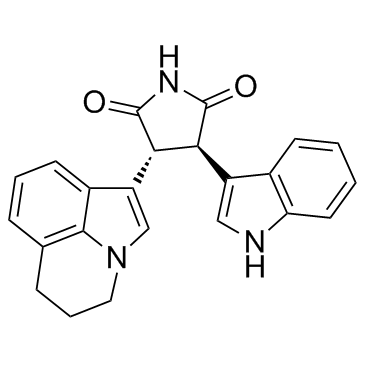
Tivantinib
CAS No. 905854-02-6
Tivantinib( ARQ-197 )
Catalog No. M16511 CAS No. 905854-02-6
Tivantinib (ARQ-197)?is a potent, selective, non-ATP-competitive inhibitor of c-Met with Ki of 355 nM.
Purity : >98% (HPLC)
 COA
COA
 Datasheet
Datasheet
 HNMR
HNMR
 HPLC
HPLC
 MSDS
MSDS
 Handing Instructions
Handing Instructions
| Size | Price / USD | Stock | Quantity |
| 5MG | 42 | In Stock |


|
| 10MG | 64 | In Stock |


|
| 25MG | 129 | In Stock |


|
| 50MG | 210 | In Stock |


|
| 100MG | 330 | In Stock |


|
| 200MG | 537 | In Stock |


|
| 500MG | Get Quote | In Stock |


|
| 1G | Get Quote | In Stock |


|
Biological Information
-
Product NameTivantinib
-
NoteResearch use only, not for human use.
-
Brief DescriptionTivantinib (ARQ-197)?is a potent, selective, non-ATP-competitive inhibitor of c-Met with Ki of 355 nM.
-
DescriptionTivantinib (ARQ-197)?is a potent, selective, non-ATP-competitive inhibitor of c-Met with Ki of 355 nM; has no inhibition for EGFR, InsR, PDGFRα, FGFR1 and FGFR4 etc., only modest inhibition (35%) for Ron at 30 uM; inhibits constitutive c-Met phosphorylation in HT29 and MKN-45 cells, and HGF-induced c-Met phosphorylation in MDA-MB-231 and NCI-H441 cells with IC50 of 100-300 nM; shows antiproliferative activity against multiple cancer cell lines (IC50=0.03-30 uM); exerts tumor growth inhibition in multiple mouse xenograft; orally active.Liver Cancer Phase 3 Clinical(In Vitro):Tivantinib (ARQ 197) selectively inhibits c-Met activity in cell-free and cell-based assays. c-Met-expressing cancer cell lines treated with Tivantinib display either a dose-dependent loss of proliferative capacity or caspase-dependent apoptosis that positively correlates with either ligand-dependent c-Met activity or constitutively active c-Met. To examine the biochemical mode of inhibition of Tivantinib, kinetic analyses are done using recombinant human c-Met in a filtermat-based assay. The Km of ATP is 50.5±2.2 μM, which is similar to the Km value of ATP. In these kinetic studies, Tivantinib inhibits human recombinant c-Met with a calculated inhibitory constant (Ki) of ~355 nM. In vitro exposure to Tivantinib inhibits constitutive c-Met phosphorylation in HT29 and MKN-45 cells, and HGF-induced c-Met phosphorylation in MDA-MB-231 and NCI-H441 cells with an IC50 of 100 to 300 nM. Tivantinib is a low-molecular-weight compound, and is the first in class orally available selective inhibitor of c-Met. (In Vivo):Pharmacodynamically, the phosphorylation of c-Met in human colon xenograft tumors (HT29) is strongly inhibited by Tivantinib (ARQ 197), as assessed by a dramatic reduction of c-Met autophosphorylation 24 hours after a single oral dose of 200 mg/kg of Tivantinib. This same dosage in mice shows that tumor xenografts are exposed to sustained plasma levels of Tivantinib, consistent with the observed pharmacodynamic inhibition of c-Met phosphorylation and inhibition of proliferation of c-Met harboring cancer cell lines. A Cmax of 5.73 μg/mL (13 μM), an area under the concentration-time curve of 12.1 μg/mL h, and a t1/2 of 2.4 hours are measured. Plasma levels of Tivantinib 10 hours after dosing are determined to be 1.3 μM, >3-fold above the biochemical inhibitory constant of Tivantinib for c-Met.
-
In Vitro——
-
In Vivo——
-
SynonymsARQ-197
-
PathwayAngiogenesis
-
Targetc-Met/HGFR
-
Recptorc-Met
-
Research AreaCancer
-
IndicationLiver Cancer
Chemical Information
-
CAS Number905854-02-6
-
Formula Weight369.4159
-
Molecular FormulaC23H19N3O2
-
Purity>98% (HPLC)
-
Solubility10 mM in DMSO
-
SMILESO=C([C@@H](C1=CN2CCCC3=C2C1=CC=C3)[C@@H]4C5=CNC6=C5C=CC=C6)NC4=O
-
Chemical Name2,5-Pyrrolidinedione, 3-(5,6-dihydro-4H-pyrrolo[3,2,1-ij]quinolin-1-yl)-4-(1H-indol-3-yl)-, (3R,4R)-
Shipping & Storage Information
-
Storage(-20℃)
-
ShippingWith Ice Pack
-
Stability≥ 2 years
Reference
1. Munshi N, et al. Mol Cancer Ther. 2010 Jun;9(6):1544-53.
2. Eathiraj S, et al. J Biol Chem. 2011 Jun 10;286(23):20666-76.
3. Previdi S, et al. Mol Cancer Ther. 2012 Jan;11(1):214-23.
molnova catalog



related products
-
Salidroside
Salidroside is a bioactive phenolic glycoside compound isolated from Rhodiola crenulata. It is a prolyl endopeptidase Inhibitor.
-
SAR125884
SAR125844 a potent and highly selective inhibitor of the MET receptor tyrosine kinase (RTK) for intravenous administration.?(IC50 value of 4.2 nmol/L).
-
NQ301
NQ301, an antithrombotic agent, inhibits collagen-challenged rabbit platelet aggregation (IC50: 10 mg/mL).



 Cart
Cart
 sales@molnova.com
sales@molnova.com


